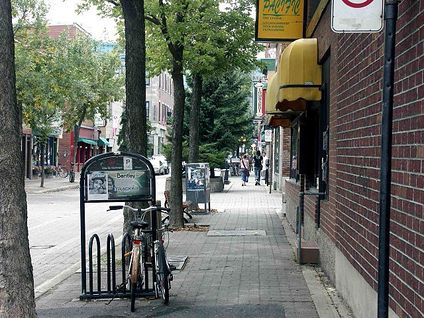m (layout) |
(→Open spaces: Saint-Michel Environnemental Complex) |
||
| (4 intermediate revisions by the same user not shown) | |||
| Line 19: | Line 19: | ||
[https://amisduchamp.com/ Les Amis du Champ des Possibles] | [https://amisduchamp.com/ Les Amis du Champ des Possibles] | ||
Wikipedia: List of parks in Montreal {{W|List of parks in Montreal}} | |||
'''Saint-Michel Environnemental Complex''' | |||
The city of Montreal acquired the Miron Quarry in 1988 to make a landfill waste site. Starting in 1995 under the direction of the city, the site was gradually altered in order to transform it into an urban green space, now comparable in size to Mount Royal Park. It is expected to become the largest urban park in the city within by 2020, with an estimated area of 192 hectares (470 acres). | |||
Nearly 75 hectares (190 acres) are still used for waste disposal. The complex also includes the park, a recyclable materials recovery facility, a biogas powerplant, a composting site and a landfill. | |||
The Centre d'expertise sur les matières résiduelles (CEMR), dedicated to the research and application of effective, environmentally friendly and sustainable waste management is located in the complex. | |||
In recent years the Cité des Arts du cirque (TOHU), a non-profit organization, is installed on the site. With multiple vocations, it has a mission to make Montreal an international circus arts capital, contributing to the environmental rehabilitation of the landfill and to support community development of the St. Michel district. {{W|Saint-Michel Environnemental Complex}} | |||
'''Montreal Archipelago Ecological Park''' | |||
(French: Parc Écologique de l’Archipel de Montréal) is a project to create a new National park within an approximate radius of 50 kilometres (31.1 mi) around the Island of Montreal, in Quebec, Canada. This project was announced to the public at a press conference in Montreal on October 1, 2007. In September 2008, environmental groups renewed calls for the Government of Quebec to create the park. {{W|Montreal Archipelago Ecological Park}} | |||
=== Sharing === | === Sharing === | ||
[http://laremise.ca/ La Remise] | [http://laremise.ca/ La Remise] | ||
[[category:Sharing cities]] | |||
| style="background:khaki" | | | style="background:khaki" | | ||
| Line 60: | Line 78: | ||
{{scaendmenu}} | {{scaendmenu}} | ||
[[category:Sustainable community action]] | [[category:Sustainable community action]] | ||
[[category:]] | [[category:Quebec]] | ||
[[category:Canadian cities]] | |||
Revision as of 18:09, 21 October 2017
 Montreal (officially Montréal) is the most populous municipality in the province of Quebec and the second-most populous in Canada. Originally called Ville-Marie, or "City of Mary", it is named after Mount Royal, the triple-peaked hill in the heart of the city. The city is on the Island of Montreal, which took its name from the same source as the city, and a few much smaller peripheral islands, the largest of which is Île Bizard. It has a distinct four-season continental climate with warm to hot summers and cold snowy winters. In 2016 the city had a population of 1,704,694. Montreal's metropolitan area had a population of 4,098,927 and a population of 1,942,044 in the urban agglomeration, with all of the municipalities on the Island of Montreal included. French is the city's official language and is the language spoken at home by 49.8% of the population of the city, followed by English at 22.8% and 18.3% other languages (in the 2016 census, not including multi-language responses). In the larger Montreal Census Metropolitan Area, 65.8% of the population speaks French at home, compared to 15.3% who speak English. The agglomeration Montreal is one of the most bilingual cities in Quebec and Canada with over 59% of the population able to speak both English and French. Montreal is the second-largest primarily French-speaking city in the world, after Paris. W Initiatives by topicCycling activismOpen spacesLes Amis du Champ des Possibles Wikipedia: List of parks in Montreal W Saint-Michel Environnemental Complex The city of Montreal acquired the Miron Quarry in 1988 to make a landfill waste site. Starting in 1995 under the direction of the city, the site was gradually altered in order to transform it into an urban green space, now comparable in size to Mount Royal Park. It is expected to become the largest urban park in the city within by 2020, with an estimated area of 192 hectares (470 acres). Nearly 75 hectares (190 acres) are still used for waste disposal. The complex also includes the park, a recyclable materials recovery facility, a biogas powerplant, a composting site and a landfill. The Centre d'expertise sur les matières résiduelles (CEMR), dedicated to the research and application of effective, environmentally friendly and sustainable waste management is located in the complex. In recent years the Cité des Arts du cirque (TOHU), a non-profit organization, is installed on the site. With multiple vocations, it has a mission to make Montreal an international circus arts capital, contributing to the environmental rehabilitation of the landfill and to support community development of the St. Michel district. W Montreal Archipelago Ecological Park (French: Parc Écologique de l’Archipel de Montréal) is a project to create a new National park within an approximate radius of 50 kilometres (31.1 mi) around the Island of Montreal, in Quebec, Canada. This project was announced to the public at a press conference in Montreal on October 1, 2007. In September 2008, environmental groups renewed calls for the Government of Quebec to create the park. W Sharing |
News and comment2017 Meet Montréal’s New Wave of Activist Developers, May 30 [1] 2015 Montréal's Blooming Social Economy Confronts Fiscal Pruning, September 21 [2] People power: the secret to Montreal's success as a bike-friendly city, June 17 [3] ResourcesCommunity resources
Interwiki linksWikipedia: Montreal External links
|